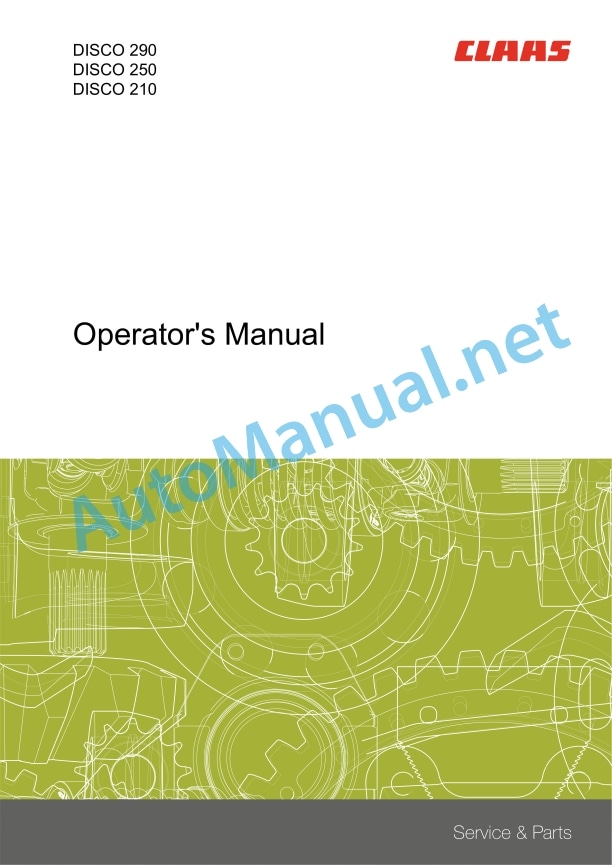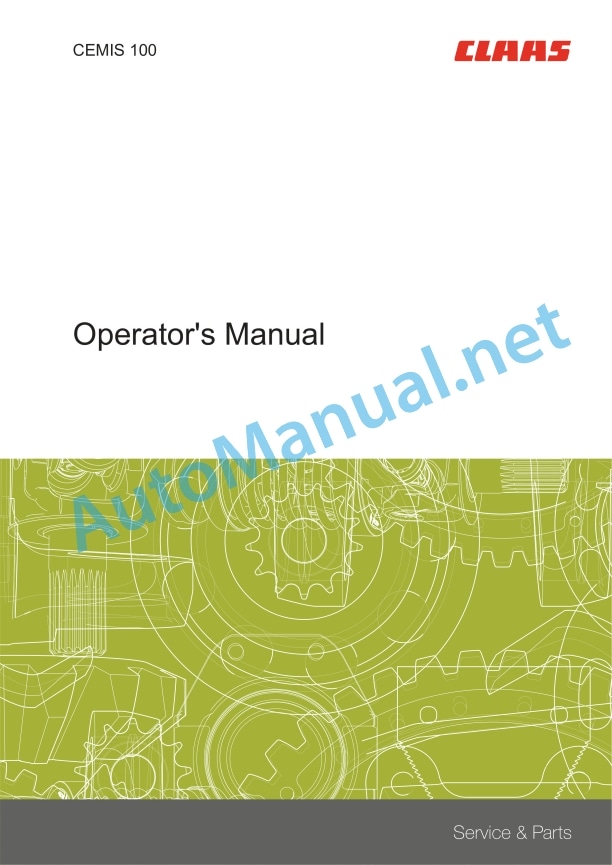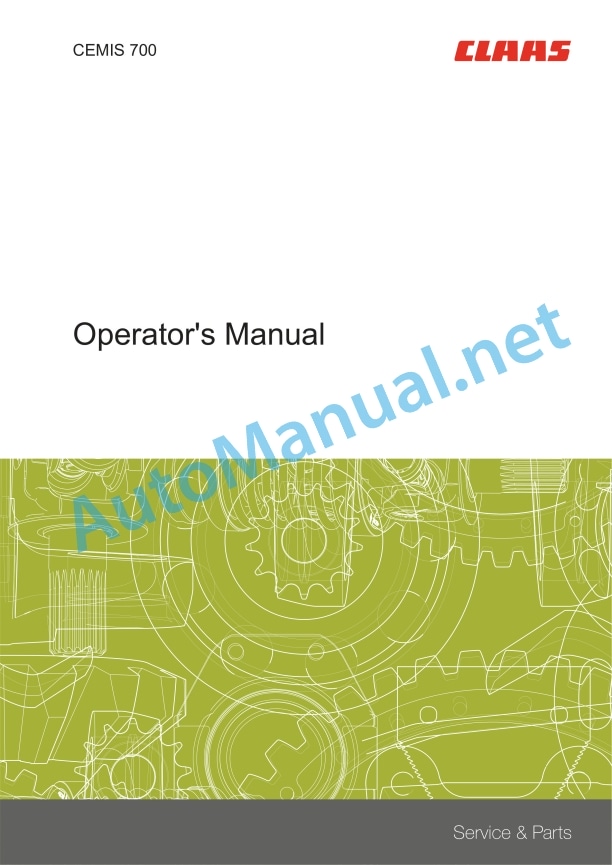Claas Disco 250 (634) Mower Operator Manual EN
$50.00
- Model: Disco 250 (634) Mower
- Type Of Manual: Operator Manual
- Language: EN
- Format: PDF(s)
- Size: 59.6 MB
File List:
00 0299 648 4.pdf
00 1329 399 0.pdf
00 2348 408 0.pdf
00 2348 427 0.pdf
00 0299 648 4.pdf:
DISCO 290DISCO 250DISCO 210
Table of contents
1 Introduction
1.1 Notes on the manual
1.1.1 Validity of the manual
1.1.2 Information about this Operator’s Manual
1.1.3 Symbols and notes
1.1.4 Optional equipment
1.1.5 Qualified specialist workshop
1.1.6 Notes on maintenance
1.1.7 Notes on warranty
1.1.8 Spare parts and technical questions
1.2 Intended use
1.2.1 Intended use
1.2.2 Reasonably foreseeable misuse
2 Safety
2.1 Identifying warnings
2.1.1 Hazard signs
2.1.2 Signal word
2.2 Safety rules
2.2.1 Importance of Operator’s Manual
2.2.2 Observing safety decals and warnings
2.2.3 Requirements for all persons working with the machine
2.2.4 Children in danger
2.2.5 Hazard areas
2.2.6 Staying between the tractor and the machine
2.2.7 Persons riding on the machine
2.2.8 Hitching the tractor to the machine
2.2.9 Risk of injury from rotating shafts
2.2.10 Structural changes
2.2.11 Optional equipment and spare parts
2.2.12 Control of the machine while it is running
2.2.13 Operation only after proper putting into operation
2.2.14 Technical condition
2.2.15 Danger due to damage to the machine
2.2.16 Respecting technical limit values
2.2.17 Danger from machine parts running on
2.2.18 Keeping the safety devices functional
2.2.19 Personal protective equipment
2.2.20 Wearing suitable clothing
2.2.21 Removing dirt and loose objects
2.2.22 Preparing the machine for road travel
2.2.23 Hazards when driving on the road and in the field
2.2.24 Parking the machine safely
2.2.25 Unsupervised parking
2.2.26 Unsuitable operating materials
2.2.27 Safe handling of operating and auxiliary materials
2.2.28 Fire hazard
2.2.29 Environmental protection and disposal
2.2.30 Lethal electrocution from overhead lines
2.2.31 Behaviour in case of voltage flash-over from overhead lines and when lightning strikes
2.2.32 Noise may cause health damage
2.2.33 Liquids under pressure
2.2.34 Hot surfaces
2.2.35 Only carry out work on the machine when it is stopped
2.2.36 Maintenance operations and repairs
2.2.37 Lifted machine parts and loads
2.2.38 Danger from welding work
2.3 Safety marking
2.3.1 Layout of safety decals
2.3.2 Safety decals on the machine
3 Machine description
3.1 Overview and method of operation
3.1.1 Machine overview
3.1.2 Overview of the cutting disc direction of rotation
3.1.3 Function of machine
3.2 Optional equipment
3.2.1 High-cut skids*
3.2.2 Wear skids*
3.3 Identification plates and vehicle identification number
3.3.1 Machine identification plate
3.4 Information on the machine
3.4.1 Stickers on the machine
4 Operating and display elements
4.1 Controls
4.1.1 Machine
4.2 Display elements
4.2.1 Frame
5 Technical specifications
5.1 DISCO 290
5.1.1 Dimensions
5.1.2 Weight
5.1.3 Requirements for the tractor
5.1.4 Version
5.1.5 Sound pressure level
5.1.6 Lubricants
5.2 DISCO 250
5.2.1 Dimensions
5.2.2 Weight
5.2.3 Requirements for the tractor
5.2.4 Version
5.2.5 Sound pressure level
5.2.6 Lubricants
5.3 DISCO 210
5.3.1 Dimensions
5.3.2 Weight
5.3.3 Requirements for the tractor
5.3.4 Version
5.3.5 Sound pressure level
5.3.6 Lubricants
6 Machine preparation
6.1 Switching off and securing the machine
6.1.1 Switching off and securing the tractor and machine
6.1.2 Securing the raised machine
6.2 Accessing workplaces and maintenance spaces
6.2.1 Folding up the front safety guard
6.2.2 Folding up the rear safety guard
6.3 Adapting the tractor
6.3.1 Checking the ballasting of the tractor
Calculating the minimum front ballast
Calculating the minimum rear ballast
Calculating the actual front axle load
Calculating the actual total weight
Calculating the actual rear axle load
Calculation table
6.3.2 Checking the protective guard on the tractor PTO shaft
6.4 Adapting the machine
6.4.1 Universal drive shaft – checking the length
6.4.2 Adapting the length of the universal drive shaft
6.4.3 Fitting the universal drive shaft to the machine
6.4.4 Adapting the lower link pin
The following options are available:
6.5 Hitching the machine
6.5.1 Fitting the lower link
6.5.2 Fitting the upper link
6.5.3 Installing the universal drive shaft
6.5.4 Connecting the hydraulic hose
6.5.5 Raising the stand
6.5.6 Laying the pull ropes
6.6 Unhitching the machine
6.6.1 Parking the machine
6.6.2 Lowering the stand
6.6.3 Removing the pull rope
6.6.4 Removing the universal drive shaft
6.6.5 Unhooking the upper link
6.6.6 Unhooking the lower link
6.6.7 Disconnecting the hydraulic hoses
6.7 Prepare road travel
6.7.1 Swinging to transport position
6.7.2 Closing the shut-off tap
6.7.3 Marking the machine for road travel
6.7.4 Performing checks prior to road travel
6.8 Preparing the working position
6.8.1 Opening the shut-off tap
6.8.2 Slewing to working position
6.9 Loading the machine
6.9.1 Loading the machine
7 Operation
7.1 Driving on the road
7.1.1 Driving on public roads
7.2 Fieldwork settings
7.2.1 Adjusting the mounting frame
7.2.2 Adjusting the mower head load relief
Changing the mower head load relief
7.2.3 Adjusting the cutting height
7.2.4 Retensioning the collision protection
7.3 Fieldwork
7.3.1 Switching the machine to transport position
7.3.2 Switching the machine to working position
7.3.3 To be observed during fieldwork
7.3.4 Machine use
7.3.5 Mowing methods
7.3.6 Lifting the machine to the headland position
7.3.7 Engaging collision protection
7.3.8 Instructions for mowing
7.3.9 Difficult operating conditions
7.3.10 Recommendation for environmental protection
8 Faults and remedies
8.1 Overview of problems
8.1.1 Problems on the machine
9 Maintenance
9.1 Service interval overview
9.1.1 Before the harvest
9.1.2 After the first 50 operating hours
9.1.3 Every 8 operating hours
9.1.4 Every 20 operating hours
9.1.5 Every 50 operating hours
9.1.6 Every 500 operating hours or annually
9.1.7 After the harvest
9.2 Gearbox
9.2.1 Checking the gearbox for leaks
9.2.2 Check the oil level of the angle drive
9.2.3 Changing the oil in the angle drive
9.3 Universal drive shafts
9.3.1 Service the universal drive shaft
9.4 Drive belt
9.4.1 Checking the drive belt
9.4.2 Tensioning the drive belt
9.5 Hydraulic system
9.5.1 Checking the hydraulic hoses
9.5.2 Installing and removing hydraulic cylinders
9.6 Mower unit
9.6.1 Check the oil level in the mower head
9.6.2 Changing the oil in the mower head
Draining oil
Topping up oil
9.6.3 Check the mower knives
Check the means of securing the mower knives
9.6.4 Replacing the mower knives
9.6.5 Clean the feed drum drain opening
9.6.6 Check the feed drum wear bars
9.6.7 Check the cover plate on the feed drum
9.6.8 Check the sealing washer of the feed drum
9.6.9 Check the cutting discs
9.6.10 Replacing the cutting discs
9.6.11 Adjust the anti-wrap guard
9.7 Assembly parts and bodywork
9.7.1 Clean the machine
9.7.2 Preserve the machine
9.7.3 Check the fittings
9.7.4 Check the safety guard holder
9.8 Lubrication plan
9.8.1 Lubricating the grease points every 20 operating hours
9.8.2 Lubricate lubrication points every 50 operating hours
10 Putting out of operation and disposal
10.1 General information
10.1.1 Removal from service and disposal
11 EC declaration of conformity
11.1 DISCO 290 / 250 / 210
11.1.1 EC Declaration of Conformity
12 Technical terms and abbreviations
12.1 Terms and explanations
12.1.1 Technical terms
12.1.2 Abbreviations
00 2348 408 0.pdf:
CEMIS 100
Table of contents
1 Introduction
1.1 General information
1.1.1 Validity of the manual
1.1.2 Information about this Operator’s Manual
1.1.3 Symbols and notes
1.2 Intended use
1.2.1 Intended use
1.2.2 Reasonably foreseeable misuse
2 Safety
2.1 Safety rules
2.1.1 General safety and accident prevention regulations
2.1.2 Interaction between terminal and machine or tractor
2.1.3 Electrocution by electrical system
3 Product description
3.1 Overview and method of operation
3.1.1 Overview of CEMIS 100
3.1.2 Function principle of CEMIS 100
3.2 Identification plates and identification numbers
3.2.1 Spare parts and technical questions
3.2.2 Identification plate of CEMIS 100
4 Operating and display elements
4.1 CEMIS 100
4.1.1 User interface for LINER
4.1.2 User interface for ROLLANT
4.1.3 User interface for UNIWRAP
5 Technical specifications
5.1 CEMIS 100
5.1.1 Specification
6 Operation
6.1 CEMIS 100
6.1.1 Operating the CEMIS 100
6.1.2 Switching CEMIS 100 on
6.1.3 Switching CEMIS 100 off
7 Maintenance
7.1 CEMIS 100
7.1.1 Daily
8 Putting out of operation and disposal
8.1 General information
8.1.1 Removal from service and disposal
9 Technical terms and abbreviations
9.1 Terms and explanations
9.1.1 Technical words
9.1.2 Abbreviations
00 2348 427 0.pdf:
CEMIS 700
Table of contents
1 Introduction
1.1 General information
1.1.1 Validity of the manual
1.1.2 Information about this Operator’s Manual
1.1.3 Symbols and notes
1.2 Intended use
1.2.1 Intended use
1.2.2 Reasonably foreseeable misuse
2 Safety
2.1 Safety rules
2.1.1 General safety and accident prevention regulations
2.1.2 Interaction between terminal and machine or tractor
2.1.3 Electrocution by electrical system
3 Product description
3.1 Overview and method of operation
3.1.1 Overview of CEMIS 700
3.1.2 Function principle of CEMIS 700
3.2 Identification plates and identification numbers
3.2.1 Spare parts and technical questions
3.2.2 Identification plate of CEMIS 700
4 Information on the product
4.1 Software version
5 Operating and display elements
5.1 CEMIS 700
5.1.1 User interface
5.1.2 Terminal program
6 Technical specifications
6.1 CEMIS 700
6.1.1 Specification
7 Operation
7.1 CEMIS 700
7.1.1 Operating the CEMIS 700
7.1.2 Switching CEMIS 700 on
7.1.3 Switching CEMIS 700 off
7.2 Terminal settings
7.2.1 Making settings
Making settings with the rotary button
Making settings with the touch function
7.2.2 Setting the screen lighting
Daytime mode
Nighttime mode
Activating automatic key lighting
7.2.3 Setting the time and date
7.2.4 Displaying diagnosis information
On-board power supply voltage display
Display of CLAAS ISOBUS ECU address and name
7.2.5 Setting the language and display formats
Setting the language
Setting display formats
7.2.6 Setting the volume
7.2.7 Deleting an ISOBUS implement
8 Maintenance
8.1 Maintenance
8.1.1 Daily
9 Putting out of operation and disposal
9.1 General information
9.1.1 Removal from service and disposal
10 Technical terms and abbreviations
10.1 Terms and explanations
10.1.1 Technical words
10.1.2 Abbreviations
John Deere Repair Technical Manual PDF
John Deere Transmission Control Unit Component Technical Manual CTM157 15JUL05
John Deere Repair Technical Manual PDF
John Deere Repair Technical Manual PDF
John Deere Repair Technical Manual PDF
John Deere Repair Technical Manual PDF
John Deere Repair Technical Manual PDF
John Deere Repair Technical Manual PDF
John Deere PowerTech M 10.5 L and 12.5 L Diesel Engines COMPONENT TECHNICAL MANUAL CTM100 10MAY11
John Deere Repair Technical Manual PDF
New Holland Service Manual PDF























